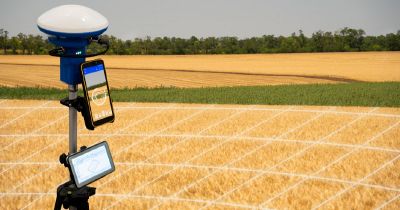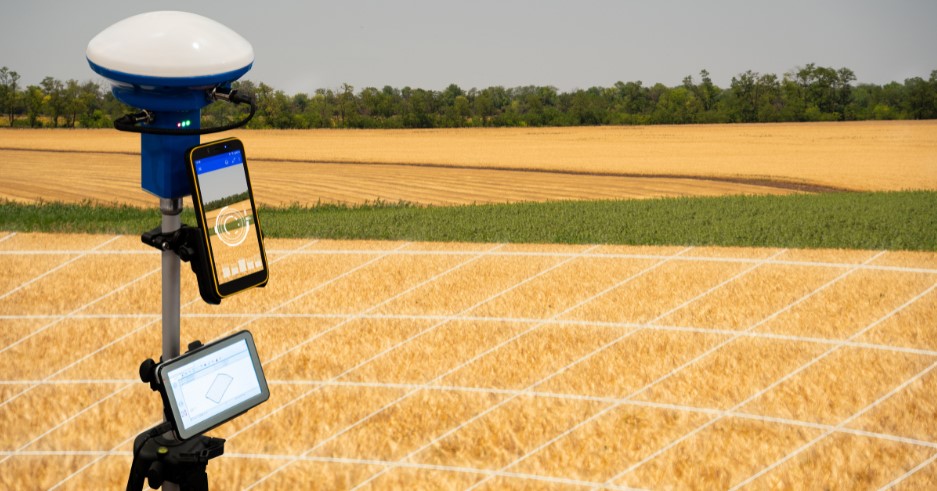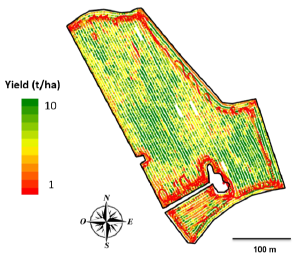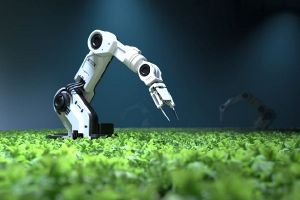 Targeted fertilisation, satellite, sensors, spreading, spraying, drones, RTK, robotisation, software...
Targeted fertilisation, satellite, sensors, spreading, spraying, drones, RTK, robotisation, software...

Precision agriculture, which originated in the United States in the 1980s, is based on the use of information and digital technologies to take account of the spatial and temporal variability of agricultural production in cultivation practices. More specifically, the International Society for Precision Agriculture(ISPA) defines precision agriculture as "a management strategy that gathers, processes and analyses spatial, temporal and individual data, and combines them with other information to guide modulated plant or animal management decisions to improve resource efficiency, productivity, quality, profitability, and sustainability of agricultural production".
Objectives
Precision agriculture aims to meet a number of economic, agronomic, environmental and social challenges[1] agrifind.fr/agriculture-de-precision-riche/
- Economic: increase average production yields and/or reduce production costs, particularly costs linked to the use of inputs. Yield heterogeneity has a natural origin (topography, lithology, etc.) as well as a human origin linked to human activity (tillage, fertiliser application, etc.). Precision farming has traditionally been used tooptimise the use of inputs, particularly nitrogen inputs.
- Agronomic: optimising the adaptation of practices to crop needs.
- Environmental: reducing certain types of pollution linked to inputs, such asnitrogen leaching, and limiting the use of water resources for irrigation.
- Social: improving comfort at work and optimising working time.
The 4 stages of precision farming
Precision farming can be broken down into four stages:
- Acquisition: collecting data to measure and quantify the variability of agricultural production.
- Characterisation: acquiring agronomic data to contextualise and give meaning to the data collected.
- Recommendations: analyse the data collected to understand the variability and choose technical itineraries that take this variability into account.
- Application: implementing crop management decisions (modulation of fertilisers, irrigation, etc.).
Data acquisition and variability measurement
Parameters measured
The information collected enables the heterogeneity of different parameters within a plot to be understood:
- The physico-chemical and biological characteristics of the soil: Conductivity or electrical resistivity maps can be used in conjunction with soil analyses and field surveys to study the condition of the soil.
- The condition of crops and/or livestock: irrigation and fertilisation requirements, stage of development, presence of pathogens, frost damage, etc.
- Climatic conditions.
Data acquisition equipment
There is a wide range of equipment and technologies for collecting data, which can be classified according to a multitude of technical or agronomic criteria: where they are located, when these digital tools are used to calculate fertiliser doses, etc.
Depending on their location, digital data acquisition tools are classified into two categories:
- Proxidetection: the data is collected by sensors located on the plot, on-board sensors on farm machinery or on a spraying boom, smartphone applications with manual input, etc.
- Remote sensing: this involves using images taken by satellites (85% of images)[2] aircraft or drones. Remote sensing provides wider spatial coverage than remote sensing.
The technologies used can also be distinguished according to whether they :
- Direct measurements.
- Indirect measurements.
In the case of nitrogen fertilisation, for example, it is possible to estimate plant nitrogen requirements using direct measurements (nitrate measurement in sap) or indirect measurements based on plant reflectance, transmittance or fluorescence to determine chlorophyll levels[3]
Most sensors and probes do not provide complete information: for example, satellite maps do measure changes in the amount of nitrogen in crops, but not the absolute quantities. They therefore need to be combined with an analysis of regular plots. Another example: pyranometers do not measure soil moisture but solar radiation. By combining this with an anemometer and a rain gauge, we can deduce soil moisture content.

Maps such as yield maps can be used to visualise the variability within a plot. The study of intra-plot variability using yield maps is most developed in the field of arable farming. [2] Combines fitted with flow sensors can measure the quantity of grain entering the hopper.
Data characterisation
The raw data collected is compared with an agronomic diagnosis to give it meaning.Artificial intelligence or simple charts can be used to infer agronomic data from measured data. For example,soil hygrometry can be estimated by modelling evapotranspiration and measuring various parameters such as sunshine and rainfall.
Recommendations and decision-making
By analysing the data, it is then possible to choose technical itineraries that take account of the variability measured. Decision-making is facilitated by the development of forecasting models andDecision Support' Tools'(DST ) such as recommendation maps. For example, crop irrigation recommendations can be drawn up on the basis of modelling irrigation requirements, linked to soil hygrometry on a plot.
Databases andartificial intelligence are key to managing and integrating the vast quantities of information generated by data acquisition and characterisation into decision-making.
Precision farming is not intended to rethink the entire operation of the existing production system. It provides measurement and diagnostic tools that can be used tooptimise the production system already in place. The computer models and other digital technologies used are not intended to replace human decision-making, but to provide objective data to facilitate decision-making.
Applying decisions
This final stage in precision farming involves implementing crop (or livestock) management decisions that take account of measured and modelled variability, in other words, implementing intra-plot modulation. The principle of intra-plot modulation can be summed up as "applying the right dose, in the right place, at the right time".
What practices are involved?

Connected equipment can be used to modulate different parameters and cultivation operations:
- Input doses.
- Sowing density.
- Soil preparation.
- Irrigation.
Precision farming has developed the most in arable farming and, to a lesser extent, winegrowing. Its most frequent application remains fertilisation management.[2]
Intervention equipment
Dose modulation can be carried out by manual application (guided by Decision Support Tools), by robotisation or by agricultural machinery.
Generally speaking, modulation equipment associated with agricultural machinery combines :
- A GNSS antenna, i.e. a GPS positioning system: there are various positioning systems (RTK, PPP, PPK, etc.) which differ in terms of the type of signal used, whether or not the positioning correction is transmitted in real time, the number of receivers used, etc. GPS-assisted section cuts can be used to limit overlaps when passing.[4]
- Equipment with flow regulation: operations can be pre-programmed or adjusted in real time.
- Guidance console: guidance consoles can operate using assisted guidance (which indicates the route to be followed without controlling the movements of the farm machinery) or self-guidance (controlling the movements of the farm machinery). Self-guidance can be electric (electric motor acting on the steering wheel or steering column) or hydraulic (acting on the hydraulic steering system).

Robotisation makes it possible to automate tasks performed by humans, for example, to bring passages closer together or to systematise them. It is also a way of dealing with the drudgery of work and the shortage of labour. For example, there are berry-harvesting robots that use artificial intelligence to recognise ripe fruit. Another example is feeding robots that can individualise rations in livestock farming.
However, robots are still not very well suited to non-standard environments, with uneven topography or difficult climatic conditions. While many initiatives are being launched, they are still rarely found on farms[5]
Modulation strategies
Two strategies for modulating input doses can be distinguished:
- Compensation strategy, which aims to increase yields in areas with low production potential by increasing input doses in these areas.
- Optimisation strategy, which aims to reduce the quantity of inputs used. This involves reducing input doses in areas where production potential is lower and limited by factors other than the quantity of inputs, such as the nature of the soil. In these areas, an increase in input doses is wasteful, as it does not increase production potential.[6]
Integration
In some cases, all these stages of precision farming are carried out separately, with separate tools that require handling by the operator (for example, extracting satellite data, correcting the data, importing the data into the tractor). In other cases, the 4 stages of precision farming are carried out simultaneously and in a fully integrated way: for example, with a nitrogen sensor combined with a GPS positioning system fitted to the tractor, which enables modulation to be carried out directly in real time.
The quality and relevance of a precision system will depend on the accuracy of the weakest of the 4 stages: if the quality of the data acquisition sensor is poor, the quality of the data analysis and the relevance of the recommendations will be affected.
Theintegration and standardisation of the 4 stages is a strong argument in favour of a functional system:
- Ease of interconnection (protocols, connectors, etc.): The ISOBUS or ISO 11783 standard was defined by theAEF (Agricultural Industry Electronics Foundation) to standardise and simplify data exchanges between different mobile equipment tools (on-board sensors on a tractor, for example), even if these tools come from different manufacturers. However, setting up a complete ISOBUS system can be fairly costly.[7]
- Better consideration of the capabilities of each sensor and each application element.
- Less interaction and handling at each stage.
Dependence on equipment suppliers
The acquisition of often complex and expensive equipment for precision farming brings with it the risk of dependence on the manufacturers of that equipment. There are several mechanisms that can force farmers to stay with the same supplier:
- Technical constraints: the interoperability of equipment or databases from different manufacturers is deliberately not guaranteed, making it impossible to use equipment from different manufacturers together or to share data.
- Legal constraints: The privatisation of data produced collectively by a small number of players, in particular manufacturers of agricultural machinery, makes it possible to limit or even prohibit their sharing. These constraints create dependency when it comes to processing the data collected. What's more, this privatised data can be used to develop and market new digital equipment tailored to a particular production method, which can lock farmers into a production logic.[8]
Sources
- This article was written with the kind assistance of Corentin Leroux. https://www.aspexit.com/
- Buffet, Dominique & Oger, R. 2000. Precision Agriculture: Data and Knowledge Base Management.https://www.researchgate.net/publication/257876410_Agriculture_de_precision_Gestion_des_donnees_et_des_bases_de_connaissances
- Leroux C. 2019. L'Agriculture de Précision en toute intimité. https://www.aspexit.com/lagriculture-de-precision-en-toute-intimite/
- Horizons. 2020. Precision Agriculture. https://leshorizons.net/cest-quoi-agriculture-de-precision/
- Ministry of Agriculture and Food Sovereignty. 2021. The major challenges of digital agriculture: equipment, agricultural models, big data. https://agriculture.gouv.fr/les-grands-enjeux-de-lagriculture-numerique-equipements-modeles-agricoles-big-data-analyse-ndeg-171
- P. Zwaenepoel, J.M. Le Bars. Precision agriculture. Ingénieries eau-agriculture-territoires, Lavoisier; IRSTEA; CEMAGREF, 1997, p. 67 - p. 79. hal-00461080. https://hal.archives-ouvertes.fr/hal-00461080/document
- Yara. 2019. Interview with Gilbert Grenier on precision agriculture. https://www.yara.fr/fertilisation/blog/agriculture-de-precision/
- ↑ :Agrifind. [10/2022]. https://www.
- ↑ 2.0 2.1 2.2 Chair AgroTIC.2018 What are the uses of remote sensing in agriculture? https://www.youtube.com/watch?v=6va_lJTITYM,
- ↑ .Leroux C. 2022. Le raisonnement de la fertilisation azotée par les outils numériques : une amourette assez fragile. https://www.aspexit.com/le-raisonnement-de-la-fertilisation-azotee-par-les-outils-numeriques-une-amourette-assez-fragile/
- ↑ Leroux. C. 2020. Geopositioning in agriculture. https://www.aspexit.com/geopositionnement-en-agriculture/
- ↑ .Leroux C.2022. Robotics in the field: where are we and where are we going? https://www.aspexit.com/la-robotique-est-dans-le-pre-ou-sommes-nous-et-ou-allons-nous/
- ↑ Spotifarm. 2021. Precision Agriculture White Paper. https://blog.spotifarm.fr/hubfs/PROMIZE/Spotifarm/livre-blanc-spotifarm-agriculture-de-precision-2021.pdf
- ↑ Leroux C. 2021. Standards and data exchange in digital agriculture. https://www.aspexit.com/standards-et-echanges-de-donnees-dans-le-numerique-agricole/
- ↑ Bertrand Valiorgue. 2020. Refounding agriculture in the age of the Anthropocene.